Reverse osmosis (or RO) systems are an ingenious water filtration setup that can provide fresh, clean water to the home. These systems are highly effective, filtering nearly all contaminants and impurities from water.
In this article, we will go through the inner workings of reverse osmosis, as well as the cost of purchasing, installing, and maintaining an RO system.
Reverse Osmosis Overview:
- What is reverse osmosis?
- Who invented RO?
- How reverse osmosis works
- What contaminants does RO remove?
- The different RO treatment applications
- RO effect on health
- RO effect on the environment
- Components of an RO system
- RO system cost and maintenance requirements
What is Reverse Osmosis?
Reverse osmosis, commonly referred to as RO, is a water purification process that uses a semi-permeable membrane to remove ions, unwanted molecules, sediments and contaminants like chlorine, fluoride, and arsenic from drinking water.
The membrane itself only allows water particles through, meaning that all the impurities (such as salt) are stuck on the other side. In general, water (such as saltwater) would have pressure applied to force it through a RO membrane.
The most common application for reverse osmosis is in the removal of salt from seawater through a process called desalination. RO can also be used in the food industry to filter out selective particles or to dealcoholized alcoholic beverages.
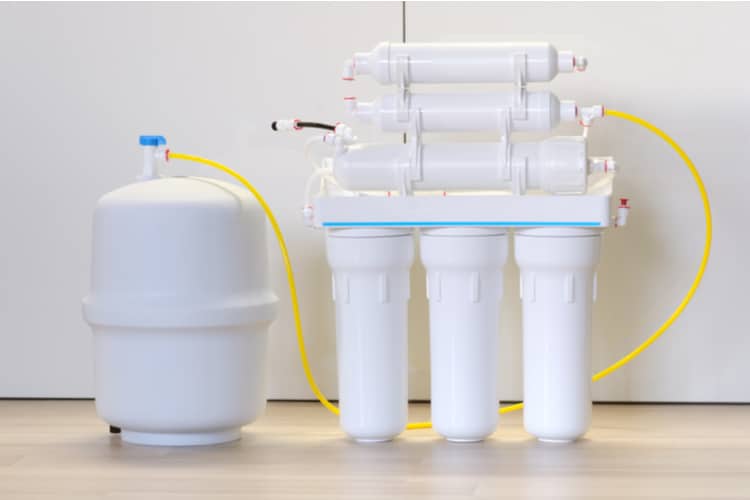
Who Invented Reverse Osmosis?
Reverse osmosis was first discovered in 1748 by French researcher Jean-Antoine Nollet. Nollet was able to reproduce the effect of reverse osmosis by filtering water through a pig’s bladder. The bladder, in this case, worked as a semi-permeable membrane. However, his research didn’t gain enough interest for nearly 200 hundred years until when a renewed interest in reverse osmosis started up in the 1940s.
During this time, many researchers from various American Universities were interested in using reverse osmosis for desalination purpose. The American researchers engineered an RO membrane that allowed freshwater particles to pass through while trapping salt particles. This was a vast improvement from Nollet’s experiment using pig bladders. They also opted to force water through membrane using pressure rather than Nollet’s passive approach.
The first commercial desalination plant was started as a pilot program in 1965 in Coalinga, California. Soon after this project got off the ground, researchers worldwide began to start work on their own desalination plants using reverse osmosis as the method of filtration.
In short, reverse osmosis was a means to provide clean drinking water to areas with very little natural freshwater but an abundance of saltwater.
RO Process: How Does a Reverse Osmosis System Work?
A reverse osmosis system works by forcing water through a semi-permeable membrane to remove dissolved solids and impurities. Generally, there will be a source of water piped into the filtration system, such as from a holding tank or a source of saltwater. This water feeds through a pump, forcing it through a membrane. The membrane stops dissolved solids and impurities from passing through, which results in clean water.
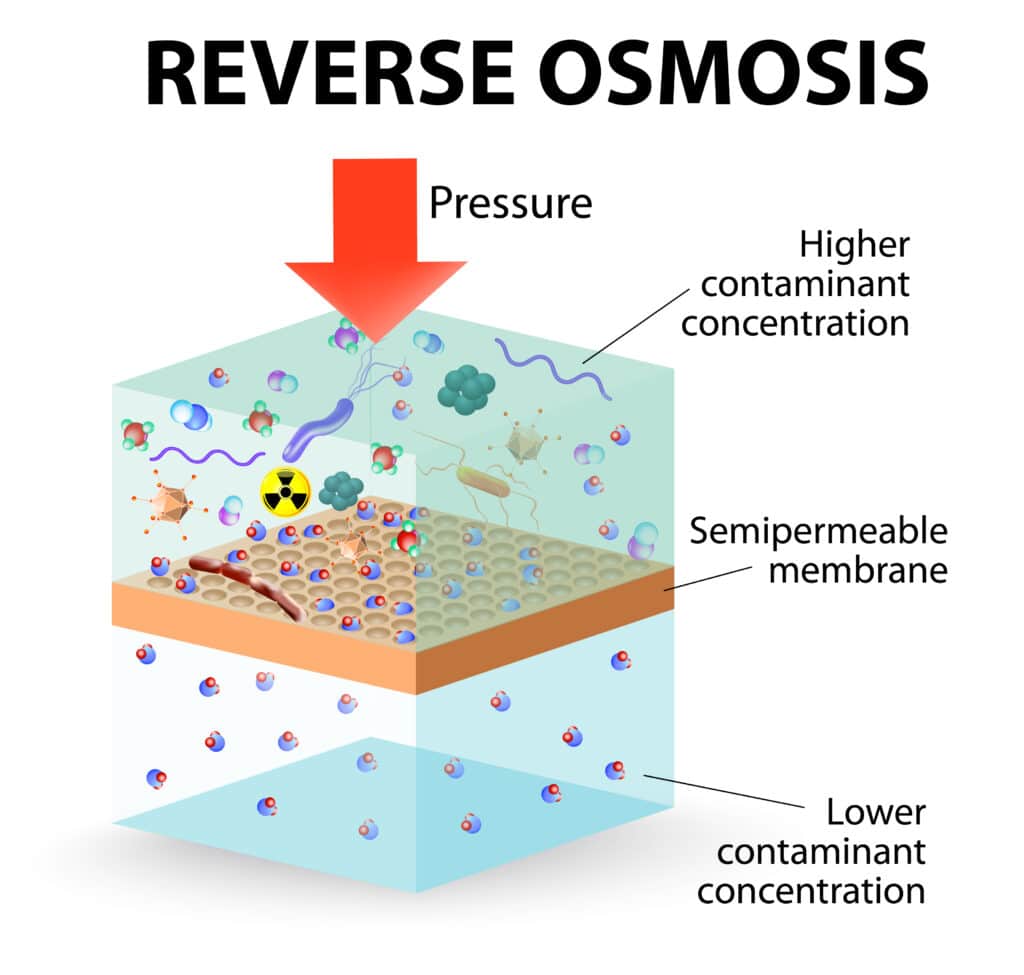
The reverse osmosis process removes up to 99% of minerals, contaminants and impurities from water. The only reason reverse osmosis can’t filter out 100% of all impurities is that some bacteria and viruses are too small to be caught by the membrane.
The impurities are caught by the reverse osmosis membrane filter off into the reject stream, where they can be disposed of. The water that passes through the RO membrane is now clean and can be collected for drinking.
The difference between reverse osmosis and standard filtered water is that a standard filter will simply trap impurities within the filter medium itself. With this kind of system, the filter needs to be changed regularly to ensure that it does not get clogged. With reverse osmosis, the impurities are free to flow off of the membrane into the reject stream.
The Different Applications of Reverse Osmosis Treatment
Reverse osmosis has many applications though it is most commonly used for desalination. Desalination is the process of removing salt from saltwater. It is highly beneficial to areas that don’t have good access to freshwater but are near saltwater.
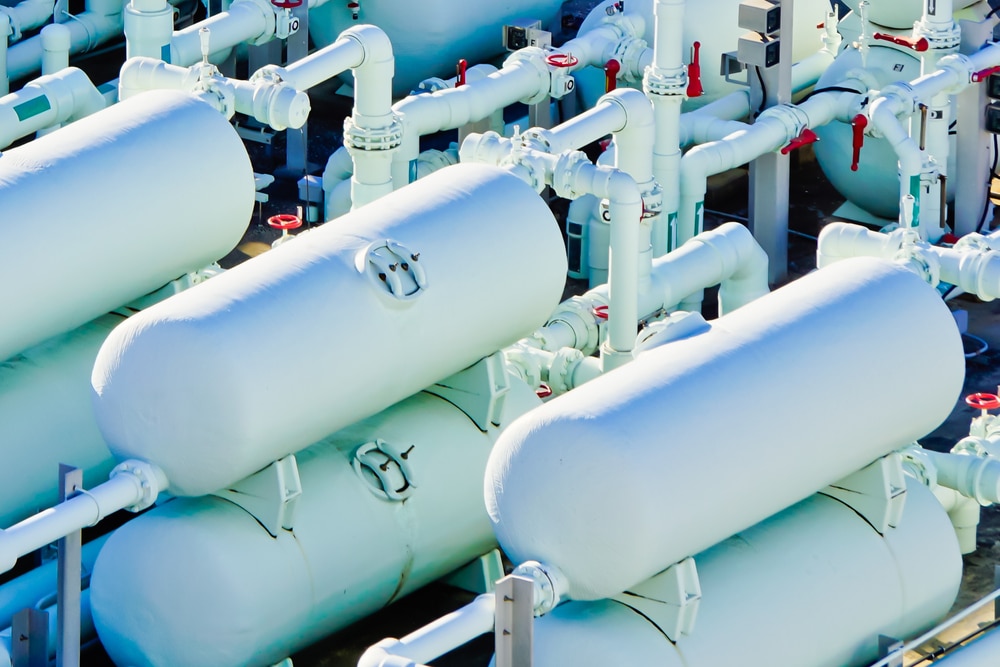
It can also be used in water purification, selective separation, and concentration.
Even in areas that don’t need desalination, reverse osmosis removes impurities from water. This is a common application in areas near peat bogs, where reverse osmosis can be used to remove organic matter from the water.
Reverse osmosis is also used in food preparation. For example, reverse osmosis separates milk and whey, or it can be used to make fruit concentrates or essential oils. Lastly, reverse osmosis can be used for de-alcoholization of alcoholic beverages.
Health Effect of Reverse Osmosis
Healthy humans can drink reverse osmosis (low tds) water with no ill effects. It is simply highly purified water with no minerals, salts, or impurities.
Removing all of the salts and impurities from water will lower the pH of RO water. For some medical conditions, such as stomach ulcers or severe acid reflux, low pH water may worsen their symptoms. For these individuals, it is recommended to find higher pH water, such as mineral water.
It’s possible to find RO water with minerals and salts added back after the filtration process to raise the pH.
How RO Compares to Bottled Water
A reverse osmosis system can be installed in residential buildings, allowing homeowners to access fresh, clean water in their own homes. On the other hand, bottled water has to be collected from its source, whether icebergs, springs, or simply the tap. They then need to be bottled, shipped, and bought before being hauled home.
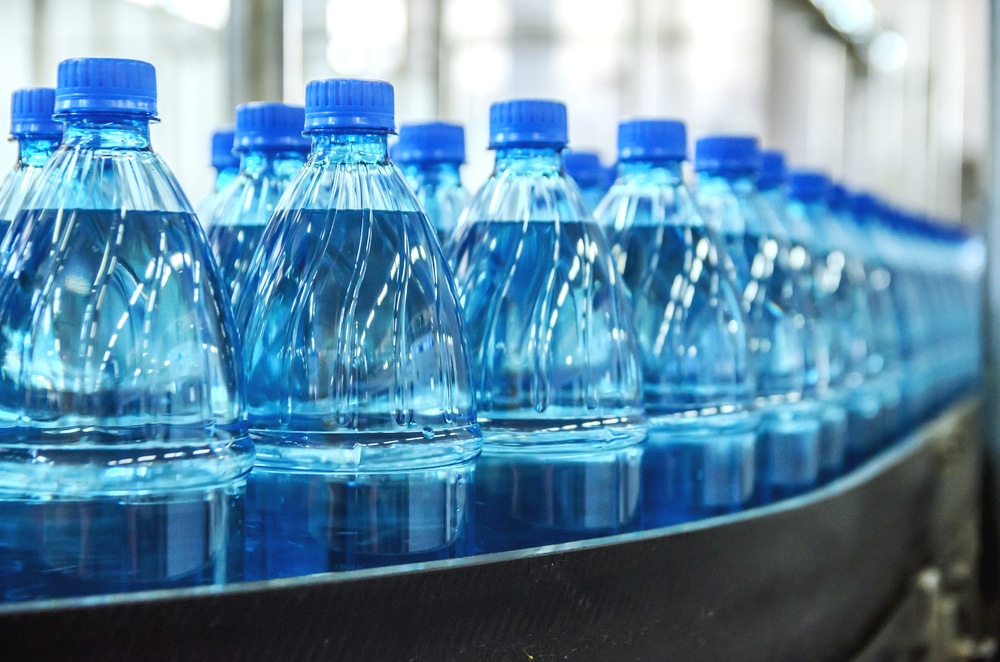
How RO Compares to Distilled Water
Distilled water is made by boiling water, catching the condensation, and turning it back into a liquid. In contrast, reverse osmosis uses a membrane to filter impurities from water.
Distilled water is often used in systems like humidifiers and c-pap machines. While both methods remove impurities, the distillation process doesn’t remove volatile compounds such as chlorine.
Distilled water isn’t practical for home use, and in most cases, if you need distilled water, you’re more likely to get it from large bottles straight from the store. Distillation can also create clean, safe drinking water for camping in a pinch.
Reverse osmosis, on the other hand, only requires a filtration system set up. Not only are more impurities cleaned from water, but you also won’t be constantly boiling water to collect the steam. For general home use, reverse osmosis is the superior option.
Environmental Effect of Reverse Osmosis
Reverse osmosis has both good and bad sides regarding environmental impact.
On the good side, drinking reverse osmosis water helps to reduce single-use plastics such as water bottles. A single reverse osmosis system can replace thousands of water bottles that otherwise would have wound up in a recycling plant or a landfill.
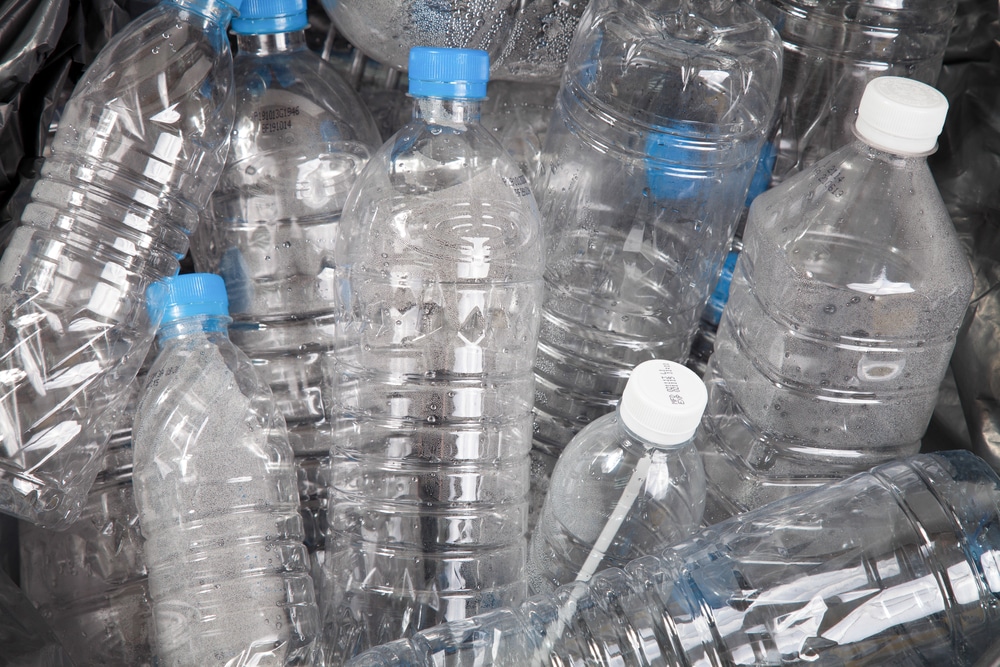
Reverse osmosis creates wastewater that isn’t nearly as harmless as typical water treatment plants. Reverse osmosis doesn’t require any harmful chemicals to clean the water and only uses a semipermeable membrane.
Reverse osmosis does have some negative effects associated with it as well. The most notable of these is the runoff from the filtration process.
This runoff is very high in salt and other impurities and is often dumped back into the environment. Large scale Reverse osmosis plants can also be quite noisy, not visually appealing, can put pollution into the air, and can affect the local aquatic environment.
What Contaminants Do Reverse Osmosis Systems Filter From Water?
Reverse osmosis systems filters up to 99% of metal ions and contaminants such as chlorine, fluoride, lead, arsenic, mercury, phosphate, sodium, nitrates, amoeba, pharmaceuticals, and bacteria. They are well known for the desalination process of removing salt from saltwater.
What Type of Water Source does a Reverse Osmosis Filter Treat?
Reverse osmosis can treat any kind of incoming water. It is well-known for using salt water as the incoming water source, as reverse osmosis is perfect for desalination.
Reverse osmosis is also commonly used in areas with a high concentration of organic matter in their water, such as near peat bogs.
For home use, a reverse osmosis system can filter the water that comes from the home’s mainline for fresh drinking water.
What is the TDS for RO?
TDS (or total dissolved solids) measures particles that remain in water after filtration. Reverse osmosis systems can lower TDS as far as 50ppm. For reference, typical tap water can be anywhere between 100 and 500ppm. Groundwater sources can have an even higher ppm.
The recommended TDS for clean drinking water that tastes great is around 150ppm. After filtering, some reverse osmosis systems will add back minerals to reach this desired mineral TDS.
Pros and Cons of Reverse Osmosis Water Treatment
- Reverse osmosis systems filter out up to 99% of all contaminants and impurities from water.
- It doesn’t use any harsh chemicals or cleaners to treat the water.
- The associated runoff isn’t nearly as toxic as traditional water treatment plants.
- Reduces the use of bottles and single-use plastics.
- A reasonably low energy system that can be used in both commercial settings and residential.
- It can provide clean, fresh drinking water to areas that may not have had access to large amounts of water in the past, such as near oceans or peat bogs.
- The reverse osmosis membrane filters off impurities rather than simply trapping them. The membrane doesn’t need to be changed as often as in typical filtration systems.
- You can choose a system that suits your needs. This can be from a small countertop system to an extensive whole house filtration system.
- Runoff from the filtration system can still be high in salts and other dissolved particles. As this is usually re-added back to the environment, it can negatively impact the local aquatic environment.
- Commercial plants can be noisy and are not visually appealing.
The Different Reverse Osmosis Water Filter Stages
Different reverse osmosis systems have a different number of stages they use to filter water. For this particular example, we’ll use a five-stage system, but other methods may have less or more.
Stage 1 – Sediment Prefilter
This stage will catch small particles such as sand and silt. Sediment filter can catch anything that is up to 15 times smaller than a grain of sand.
Stage 2 – Carbon Prefilter
The carbon pre-filter contains activated carbon that will remove impurities that can affect the taste and smell of water. This step will remove compounds such as chlorine.
Stage 3 – Second Carbon Prefilter
This stage will run the water through a second carbon filter that contains more activated carbon.
Stage 4 – RO Membrane
At this stage, water passes through a semi-porous membrane, and any remaining impurities are filtered off the water. The impurities and runoff are removed from the system, and the now clean water moves on to the next stage.
Stage 5 – Polishing Filter
The polishing filter is yet another activated carbon filter that will remove any lingering tastes or smell that may still be in water. After this stage, water will be crystal clear and ready for drinking.
Other systems will typically add or remove additional filters aside from the reverse osmosis membrane. For example, a three-stage system will have a carbon pre-filter, reverse osmosis membrane, and carbon post-filter. This option forgoes the large particle filter and additional carbon filter altogether.
Components of a Reverse Osmosis System
There are many components that make up an RO system. To start, we have the filters. Different designs will have a different number of filters. Still, generally, you will have a sediment filter for larger particulates, a carbon pre-filter, the RO membrane, and a carbon post filter.
Some systems won’t have the particulate filter, and some will have more or fewer carbon filters. To pipe in the water, you will need a feed water valve. The feed water valve will connect the cold water line to the reverse osmosis system.
The system will contain an automatic valve shut off. This will be placed after the filters and will automatically stop water flow once the pure water holding tank is nearly complete. The drain valve will be responsible for draining off the wastewater and particulates that are caught by the RO membrane.
The bladder storage tank is where the filtered water will be held until it is needed for consumption. As RO can sometimes be a slow process, it is impractical to expect water on demand with this system.
So instead, water is filtered through and held in a tank until the tank is nearly complete and activates the automatic shut-off valve. Whenever water is removed from the tank, the valve will open again and allow filtered water to fill the tank.
The drinking water faucet is often a tiny faucet on a sink that feeds directly from the RO storage tank. RO systems require plenty of tubing, usually to get the water from filter to filter, to that tank, and up into the faucet.
Finally, quick connect fittings are used to connect the tubing and components.
The Most Popular Reverse Osmosis Water Filter Brands
While there may be plenty of reverse osmosis systems currently on the market, not all of these systems are created equal.
We have gathered a list of some of the most popular brands. It should be noted that we focused on residential systems rather than commercial scale for this list.
- APEC Water
- Waterdrop
- Home Master
- AquaTru
- iSpring Water Systems
- PureDrop
What are the Most Popular RO Systems?
We focused on curating the widest variety of RO systems for this list. This means that every one of the filters we pick is the best for its reasons. To find the right one for you, consider your needs and where you plan to set them up.
For a more comprehensive list, refer to our separate article on the best reverse osmosis systems.
APEC ROES-50:
This system is considered one of the best overall RO systems for household use. It uses a five-stage filter system that gets your water crystal clear. The only downside to this system is that there is no remineralization, so the water may taste flat compared to other options.
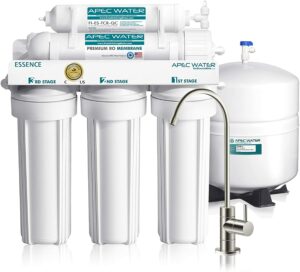
The APEC system installs under a sink and includes a faucet and a 4-gallon storage tank. It can filter up to 50 gallons of water today and is perfect for up to a four-person home. Larger families may find that the storage tank doesn’t have enough capacity for their needs.
AquaTru Countertop Filter
This is an excellent option for those who either don’t want to install an extensive bulky system under the sink or are in a rental situation where they can’t do that. It is also a good option for those who don’t need a large capacity storage tank.
This system uses three filters, sediment, carbon, and RO filter. Instead of connecting directly to the waterline, this RO system has a 1-gallon tank that can be filled with tap water. It can produce up to 3 liters of filtered water in just a few minutes. This water can then be kept in the machine or transferred into a jug and placed in the fridge.
The only downside of this system is that it will take up some counter space (unless you want to store it away after filling a jug of water). Unlike other systems, this one also needs to be plugged into a wall outlet to operate.
Waterdrop D6 RO Filter
While under the sink system is the typical setup for a reverse osmosis system. Not everyone has the space to dKind Water Systemste to a large tank and all of those filters. Not to mention, individually changing out filters can be a hassle.
This RO system from Waterdrop takes care of the hassle of changing filters and removes the tank all at once. This particular system doesn’t use a water storage tank, instead can filter water fast enough to use on-demand. The procedure itself uses five filters housed in a single condensing unit.
Waterdrop makes changing the filters easy as all you need to do is replace the whole filtration unit once a year. The included faucet also has an intelligent sensor to tell you the TDS of the water as you are dispensing it—an excellent feature for when you want to keep an eye on the life of your filters.
iSpring RCC7AK
All of the previous options didn’t include the possibility of remineralization. The water from those systems may come out tasting a bit flat. This system, however, is the best option if you would prefer a remineralization option. This system has a six-stage filtration rather than the standard five filters, with the final filter adding back alkaline minerals. This will create better-tasting water and slightly less acidic water.
There are a couple of downsides to this system, however. The main one is that it is a tad more significant than the average reverse osmosis system and will take up more space under your sink. This system also has a much higher ratio of wastewater to pure water at 3:1.
Home Master TMHP HydroPerfection
Finally, we have the Home Master option. This system is perfect for those who live on well water and is the only system we have seen so far that includes a UV light filter for sterilization. It consists of a five-stage filter process before finishing under UV light. The UV light will be able to fill off any remaining microorganisms that we can pass through the RO membrane.
This system includes UV housing. It is a little more expensive than other options. It also doesn’t have housing for the separate filters, so visually, the setup can look a little unappealing. However, the lack of housing makes it very easy to swap out filters as needed and causes, so no biofilm has the chance to build upon the inside of the filter housing.
RO System Cost and Maintenance Requirements
Once installed, reverse osmosis systems are relatively easy to maintain. The main thing is to replace the filters on a regular schedule. The schedule for replacing the filters changes from system to system, but generally, the filters should all be changed about once a year.
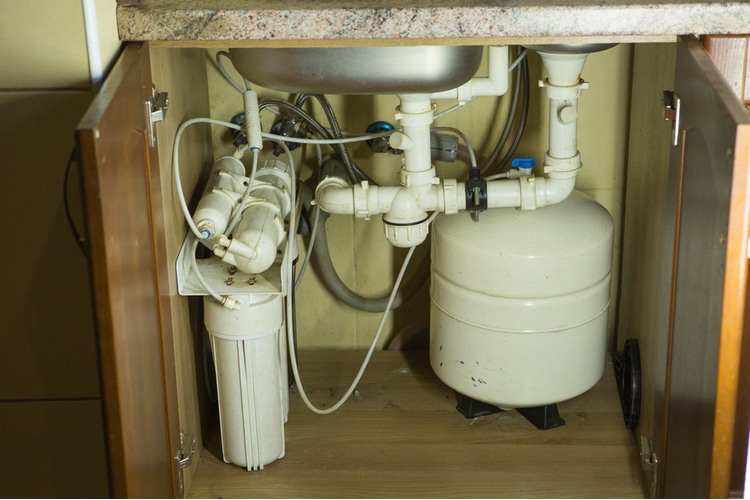
Depending on your watercourse, some filers may need to be swapped out more frequently. For example, if you live in an area with lots of particulates in the water, the first stage filter may need to be replaced every six months rather than annually. For this reason, many systems include a transparent first-stage filter so that you can see when it is time to change it.
Beyond that, the primary maintenance comes from simply keeping an eye out for leaks and ensuring that the entire system is stored nice and tidy under the sink where nothing can harm it.
How Much Does An RO System Cost?
The short answer to this is, it depends. Thanks to the wide variety of system types, filters, and so on, there is a pretty significant price range in reverse osmosis systems.
On the least expensive end, you may expect to spend a little under $200 for a reverse osmosis system. It is important to note that the budget options may not have a large capacity, or the filters may not last as long as the more premium options.
You likely won’t see some more specialized options, such as remineralization or UV filters. If you’re only looking for a primary opportunity, around $200 is a great starting point for a sound quality system.
On the other end of the spectrum, you have systems that cost upwards of $500. The Home Master system that was included in our list of top reverse osmosis systems that had UV light was among those that cost close to $500.
For the extra money, you get a system capable of killing off microorganisms that ordinarily would be so small that they would slip past the RO membrane. It is little wonder that the Home Master system is capable of filtering even well water at that price.
This doesn’t include whole-home systems that filter the water for the entire house. These systems start at $500 at the low end and can go up to $15,000 at the higher end. This cost depends mainly on the amount of water needed, the complexity of the setup, and the filters used.
How Much Does the Membrane Cost?
Most reverse osmosis membranes may cost around $50. Some may be a little more, some a little less, but most residential varieties will be about the price.
In most cases, you will be replacing the membrane about once a year. If you are using the system a lot, you may need to change it more frequently, as soon as you notice the signs of a bad ro membrane.
How Much Does It Cost to Install?
Again the answer to this question is, it depends.
As for the under-sink system, the type we have been focusing on, it may only cost a couple hundred to install. These systems are relatively easy to install, and it could only take a professional about an hour to complete. A homeowner with enough plumbing know-how could even do it themselves if they wanted.
The cost is a bit more for reverse osmosis systems that filter the water for a whole house. Whole-home systems are often more complex, requiring a plumber to hook up to the main water line coming into the house. For these systems, it may take up to $400 for a complete installation.
Again, this job should only take an hour or two to complete for a professional plumber. For whole-home installations, it is strongly recommended to hire a professional.
How Much Does It Cost to Maintain?
Once the system is installed, there is a meager cost to maintain it. The bulk of the maintenance fees comes from replacing the filters, which is done about once a year. The membrane itself is around $50 to return, and other filters may be $20 or $30 dollars.
To help manage the cost of filter replacements, you can often find them in sets for around $100 for all the required filters. Again, that’s just $100 to cover you for the entire year.
The only maintenance cost that may pop up is if you need to replace a faulty bit of tubing or a fitting. These parts are relatively inexpensive and should not be a typical cost.
Most Common RO System Problems:
- Reverse osmosis bladder tank has ruptured
- Reverse osmosis low water pressure
- Reverse osmosis system is constantly draining
- Reverse osmosis tank is not filling up
Common RO Questions
We have gathered a few common questions that arise when someone is looking into installing a reverse osmosis system into their own home.
The amount of water an RO system can produce a day depends largely on the system itself. For example, a smaller under-the-sink system may only be able to make around 50 gallons a day.
This is usually adequate for a small family. A whole-home installation, on the other hand, can filter up to 1200 gallons in a single day.
When looking for a RO system, it is important to pay attention to the output that it is capable of in a single day to ensure that it is enough for you and your family.
A reverse osmosis system doesn’t make a lot of noise. At most, you may hear a soft humming come from the system when it is filtering water. When the tank is full again, that sound will stop. Occasionally you may hear a faint gurgling as well.
If the reverse osmosis system starts to get truly noisy, then that is your sign that there is a problem within the setup. For example, a hissing noise is a sign that air has entered the system. This is a common problem after the filers are replaced. Luckily the hissing noise shouldn’t take long to go away.
Most small noises should go away within a couple of days. If you hear something that concerns you, or if noise is going on for a long time, then don’t be afraid to reach out to a plumber or water treatment expert to take a look at your RO system for any issues.
There are only a couple of reasons why reverse osmosis water may bad for you. The first, and the most important of the two, is if you have a health condition that requires high pH water.
Some medical conditions, such as ulcers and severe acid reflux, can be worsened by low pH water. Reverse osmosis can lower the pH of water as it removes all the minerals and contaminants.
Another case where you shouldn’t use reverse osmosis water is in medical equipment. Equipment such as c-pap machines and humidifiers often specify using only distilled water. If your medical device determines that it requires distilled water, then use that over reverse osmosis.
Finally, reverse osmosis can make water taste a bit flat, thanks to most minerals being removed. If you really enjoy great-tasting water, reverse osmosis may not be for you.
However, you can get some reverse osmosis systems that will add minerals back into the water after passing through the RO membrane, fixing these issues.
If you still aren’t convinced about the RO process, there are several healthy reverse osmosis alternatives you can use in place of an RO system.
RO water can taste funny or look cloudy because all the minerals in water are removed during the filtration process. When drinking tap or mineral water, much of the taste comes from the minerals that are in the water. In a reverse osmosis system, those minerals are removed by the semi-permeable membrane. The end result is water that can taste a bit flat to the average person.
However, it should be noted that some reverse osmosis systems include a filter that adds minerals back into the water, which improves the taste.
On the other hand, if your reverse osmosis system is used to provide great-tasting water, the change in taste may be a sign that it is time to change your filters. It is usually the activated carbon filters that help remove foul tastes and smells from the water. So if you notice a taste that wasn’t there before, look into changing out those carbon filters and see if there is any improvement.
Yes, you can connect reverse osmosis to refrigerator. Most under sink systems include hooking into the cold water line, filtering it, and holding it in a storage tank. This water is then usually piped up through a separate faucet.
Someone experienced in plumbing could easily run a line from the system storage tank into the fridge. The fridge would then be able to use the RO water through its dispenser and to make ice cubes.
Yes reverse osmosis can make ice cubes. The cloudiness in ice is generally caused by minerals and impurities in the water. If you make ice cubes with RO water, the ice cubes will come out incredibly clear.
Also, ice cubes made with RO water will have almost no taste, meaning they won’t add a taste to your drink.
If you notice your ice cubes getting cloudy over time, it may be a sign that it is time to change out the filters of your reverse osmosis system.
Yes, Like all water, RO water can be frozen and even used to make ice cubes. The lucky thing about reverse osmosis ice cubes is that they are usually more clear than tap water ice cubes, thanks to the impurities being filtered out through the RO system.
Reverse osmosis ice also has almost no taste and won’t add a flavor to your drink.